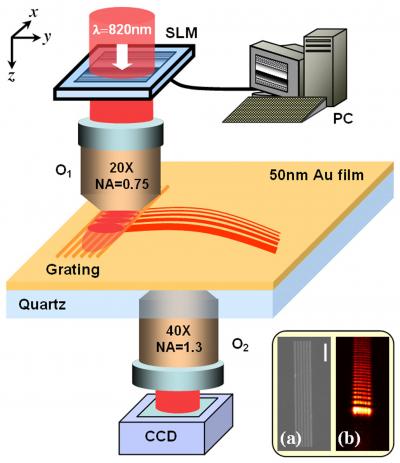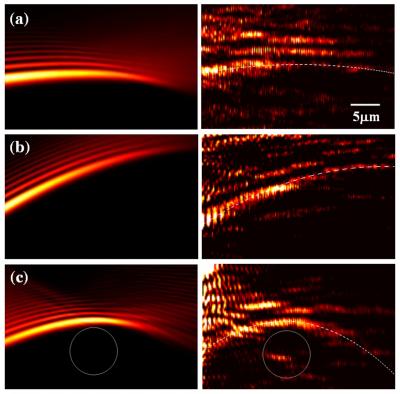New tool may yield smaller, faster optoelectronics
August 15, 2011

Through a grating coupler (a), a plasmonic beam in free space (b) generated with a computer addressed spatial light modulator (SLM) is directly coupled into surface plasmon polaritons monitored via leakage radiation microscopy. The on-the-fly adjustment of the created plasmonic beam is achieved by displaying an animation of specially designed patterns in the SLM (credit: Optics Letters/Peng Zhang, UC Berkeley and SFSU)
Steering a beam of “virtual particles” has enabled a team of scientists at the National Science Foundation (NSF) Nanoscale Science and Engineering Center of the University of California, Berkeley, to manipulate ultra-small-scale particles in real time.
The researchers manipulated a blended stream of light and plasma, known as a plasmonic Airy beam. When the beam first strikes a metal surface (typically a grating structure), it stirs up small waves of electrons at the metal-insulator interface. These waves (or “virtual particles”) are also known as surface plasmon polaritons (SPPs). They follow the curved trajectory of the Airy beams. The SPPs can then be directed to manipulate ultrafine-scale features on the surface of a metal.
The ability to manipulate the Airy beam and therefore the SPPs in real time gives scientists on-the-fly control. Using computer-controlled optics, the scientists have developed a way to steer and manipulate the beams, precisely directing their trajectories to specific spots on an optical surface and adjusting them as needed. Because of their unique arc-shaped paths, the beams have the added ability to bypass surface roughness and defects, or even vault over obstacles.

On-the-fly control of the plasmonic Airy beams, including switching the trajectories to different directions (a,b) and bypassing obstacles -- the gray solid circles in (c) -- along curved paths, where the left and right column correspond to numerical simulations and experimental demonstrations, respectively (credit: Optics Letters/Peng Zhang, UC Berkeley and SFSU)
The Airy beams used to direct the flow of plasmons also remain coherent, not fanning out or distorting as they travel along their curved trajectories, much in the same way that laser light remains coherent even after traveling great distances.
To create the Airy beams, the researchers used a laser beam and modulated its phase, or wave front, with a spatial light modulator (a device similar to a miniature liquid crystal display) controlled by a personal computer. By continuously changing the specially designed patterns in the computer, they were able to dynamically control the trajectories of the beam in real time.
“These results point out a new direction for dynamically routing surface energies without any permanent guiding structures,” says Peng Zhan of the NSF Nanoscale Science and Engineering Center, “which could inspire researchers from different areas to develop new technologies or tools for a variety of applications.”
Ref.: Peng Zhang, et al., Plasmonic Airy beams with dynamically controlled trajectories, Optics Letters, 2011; [DOI: 10.1364/OL.36.003191]